Chapter: Civil : Structural dynamics of earthquake engineering
Response of structures to earthquakes: analysis of shear walls
Response
of structures to earthquakes: analysis of shear walls
Abstract:
Shear
walls possess adequate lateral stiffness to reduce inter-storey distortions due
to earthquake-induced motions. In this chapter, analysis of shear walls with a
moment resisting frame using the Khan and Sbarounis method is discussed. When
two or more shear walls are connected by a system of beams or slabs total
stiffness exceeds the summation of individual stiffness. Openings normally
occur in vertical rows throughout the height of the wall and the connection
between wall cross-section is provided by connecting beams. Such shear walls
are called coupled shear walls. The analysis of coupled shear walls by RosmanŌĆÖs
continuous medium method is also discussed.
Key words: shear
wall, egg crate, lazy S curve, coupled shear wall, continuous medium.
Introduction
Frame
action is obtained by the interaction of slabs and columns and this is not
adequate to give the required lateral stiffness for buildings taller than about
15ŌĆō20 storeys. Shear walls must be strategically located as shown in
Fig. 21.1.
The walls can be planar,
open sections or closed sections as shown in Fig. 21.2. They are provided
around elevators and staircases. Shear walls of skewed and irregular layouts
require 3D analysis to determine the distribution of lateral loads. The shear
wall in essence behaves as a deep and slender
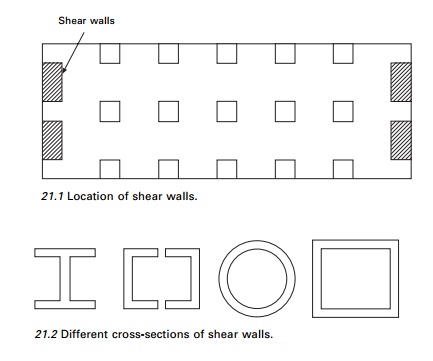
cantilever.
When no major opening is present, stresses in the walls can be determined using
simple bending theory. Complicated shapes are analysed using finite element
analysis.
The term ŌĆśshear wallŌĆÖ is a misnomer as far as the high-rise
building is concerned, since a slender wall when subjected to lateral force has
predominant moment deflections and only very insignificant shear distortion.
Major shear walls are usually positioned in the transverse direction,
separating individual compartments. Stability in the longitudinal direction is
provided by elevator shafts or some longitudinal shear walls. They are known as
egg crate or cross-wall buildings. They are extremely rigid in the
direction of shear walls.
Hence shear walls possess
adequate lateral stiffness to reduce inter-storey distortions due to
earthquake-induced motions. Shear walls or structural walls reduce the
likelihood of damage to nonstructural elements of a building. When used with
rigid frames, walls form a system that combines the gravity load-carrying
efficiency of the rigid frame with the lateral load-resisting efficiency of the
structural wall. Significant energy dissipation capacity lakes place.
There is consistently better performance of shear wall buildings during
earthquakes. They are better both with respect to life safety and damage
control. Greater lateral stiffness is introduced in earthquake-resistant
multi-storey shear wall buildings.
Shear
wall frame
Without
question this system is one of the most, if not the most, popular systems for
resisting lateral loads. The system has a broad range of applications and has
been used for buildings as low as 10 storeys to as high as 50 storeys or even
taller buildings. With the advent of haunch girders the applicability of the
system is easily extended to buildings in the 70ŌĆō80 storey range.
1 Shear wall frame interaction
This interaction has been
understood for quite some time. The classical mode of the interaction between a
prismatic shear wall and a moment frame is shown in Fig. 21.3. The frame
basically deflects in a so-called shear mode to which the shear wall
predominantly responds by bending as a cantilever.
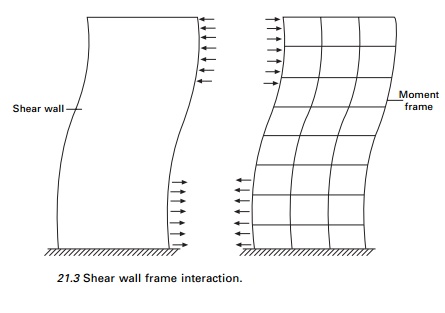
Compatibility of horizontal deflection produces interaction
between the two. The linear sway of the moment frame, when combined with storey
sway of shear walls, results in enhanced stiffness because the wall is
restrained by the frame in the upper floor while at lower levels the frames
restrained by the wall, resulting in deflected shape in the form of a ŌĆślazy
SŌĆÖ curve.
However, it is always easy to differentiate between modes. A
frame with closely spaced columns with deep beams tends to behave more or less
like a shear wall in bending mode, while the wall weakened by large openings
tends to act more or less like a frame deflecting in shear mode. The combined
structural action therefore depends on the relative rigidity of the two and
their modes of deformation.
The
simple interaction diagram shown in Fig. 21.3 is valid only:
ŌĆó
if the shear wall and frame have constant
stiffness throughout the height;
ŌĆó
if stiffness varies, the relative stiffness of the
wall and the frame remains unchanged throughout the height.
First
consider an example of shear wall with moment resisting frame analysed by the
Khan and Sbarounis (1964) method.
Example 21.1
Analyse the building shown
in Fig. 21.4 for a uniform lateral load of 1.5 kN/m2 which is the
result of earthquake motion. All girders are 300 ├Ś 500 mm.
Solution
IG = 8.859
├Ś 109
mm4 (includes slab) except 3 m link beam (250 ├Ś 400 mm size). ILB = 3.25 ├Ś 109 mm4 (link beams are assumed to be
hinged). E (concrete) = 20 GPa.
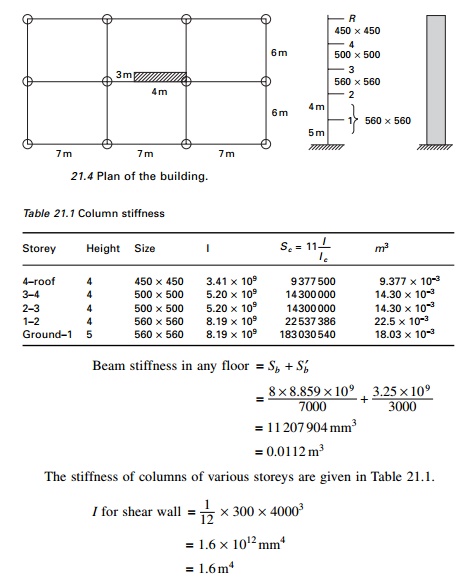
=1.6 ├Ś 1012 mm4
=1.6 m4
Lateral load due to
earthquake (for the whole frame)
On the
nodes 2, 3, 4, 5 = 1.5 ├Ś 4 ├Ś 12
= 72 kN
On node 1
= 1.5 ├Ś 4.5 ├Ś 12
= 81 kN
Step 1 Estimate wall deflections. For
the approximate analysis, compute deflection of the wall having I
= Iw + Ic (1.6 + Ic)
loaded with full lateral load. The deflection is computed using NewmarkŌĆÖs
method. Ic is comparatively smaller and hence need not be taken into
account. The calculations are shown in Fig. 21.5.
Step 2 For the frame to fit the wall and
compute the moments by using anti-symmetric loading on a symmetrical
structure to reduce the frame to single column frame. Distribution factors are
given in Table 21.2 and shown in Fig. 21.6.
Beam stiffness = 1.5 ( S b
+ SbŌĆ▓ ) =
0.0168 m3
Fixed end moment in
columns due to 0.001 drift
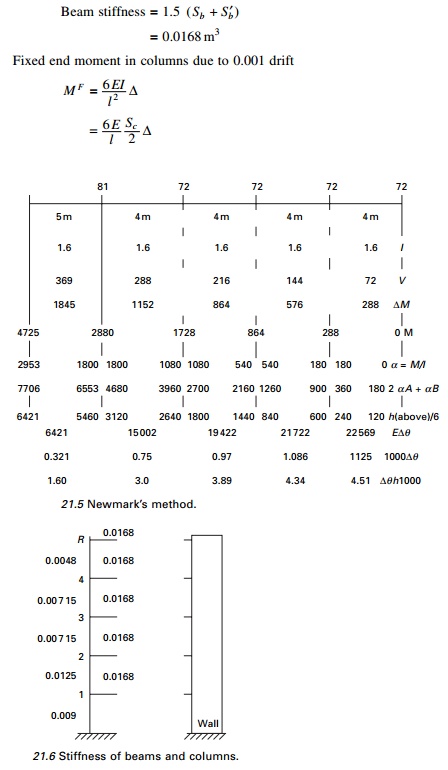
The fixed moments due to
drift are shown in Table 21.3. Moment distribution is carried out as shown in
Table 21.4. Now the wall has to be analysed for the loading condition as shown
in Fig. 21.7. The convergence characteristics are given in Fig. 21.8. The free
body diagram is shown in Fig. 21.9.

Coupled shear walls
When two
or more shear walls are connected by a system of beams or slabs, total
stiffness exceeds the summation of individual stiffness. This is because the
connecting beam restrains individual cantilever action. Shear walls resist
lateral forces up to 30ŌĆō40 storeys (see Fig. 21.10). Walls with openings
present a complex problem to the analyst.
Openings normally occur in
vertical rows throughout the height of the wall and the connection between wall
cross-sections is provided either by connecting beams which form part of the
wall or floor slab or a combination of both. The terms ŌĆścoupled shear wallsŌĆÖ,
ŌĆśpierced shear wallsŌĆÖ and ŌĆśshear wall with openingsŌĆÖ are commonly described for
such units. If the openings are very small, their effect on the overall state of
stress in the shear wall is minimal. Large openings have a pronounced effect
and if large enough result in a system in which frame action predominates. The
degree of coupling between two walls separated by a row of openings has been
expressed of geometric parameter ╬▒ (having a unit of 1/length) which it gives a measure of
relative stiffness of beams with respect to that of walls. When ╬▒H exceeds
13, the walls may be analysed as a single homogenous cantilever. When ╬▒H<0.8
the wall may be analysed as the separate cantilever, 0.8<╬▒H<13,
the

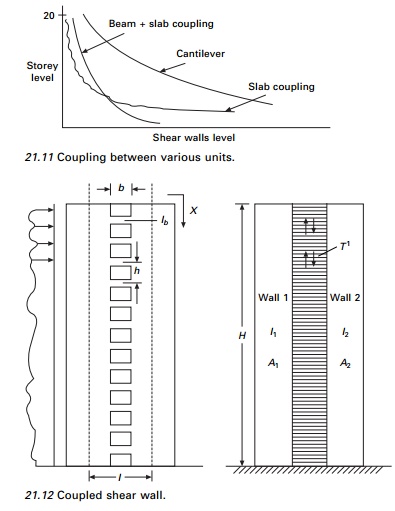
stiffness of connecting
beam must be considered. The effectiveness of coupling can clearly be seen in
Fig. 21.11.
1.Continuous medium method due to Rosman (1966)
The
individual connecting beams of finite stiffness Ib are
replaced by an imaginary continuous connection or lamina. The equivalent
stiffness of the lamina for a storey height h is Ib/h,
giving stiffness of Ib/h dx for a height of dx
(see Fig. 21.12).
When the wall is subjected
to horizontal loading, the walls deflect, inducing vertical shear force in the
laminas. The system is made statically determinate by introducing a cut along a
centre line of beams, which is assumed to lie on the points of contra-flexure.
The displacement at each wall is determined and by considering the
compatibility of deformation of the lamina, a second order differential
equation with the vertical shear force as a variable is established. The
solution of the differential equations with fixed base boundary conditions is
most common loading to an equation for the integral shear T from which
the moment, axial loads in the walls can be established and all the other
quantities can be written.
E ŌĆō Modulus of
elasticity
b ŌĆō Width of opening
Ab ŌĆō Area of connecting
beam
I ŌĆō I1
+ I2
G ŌĆō Shear modulus
Ib ŌĆō Moment of inertia
of connecting beam including shear deformation
d ŌĆō depth of
inter-connecting beam
╬Į ŌĆō
PoissonŌĆÖs ratio
╬▒, ╬▓, ╬▓, are the parameters given by
following equations:
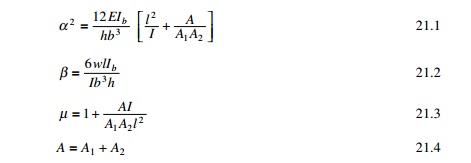
Under
lateral loads the two ends of the beam experience a vertical displacement
consisting of contributions ╬┤1, ╬┤2, ╬┤3 and ╬┤4 as shown
in Fig. 21.13
Wall rotation
The relative displacement ╬┤1 due to
bending of each wall element is given by

Beam bending
The shear force V =
qh acting at each floor level at the centre of connecting beams with
centre relations displacement ╬┤2
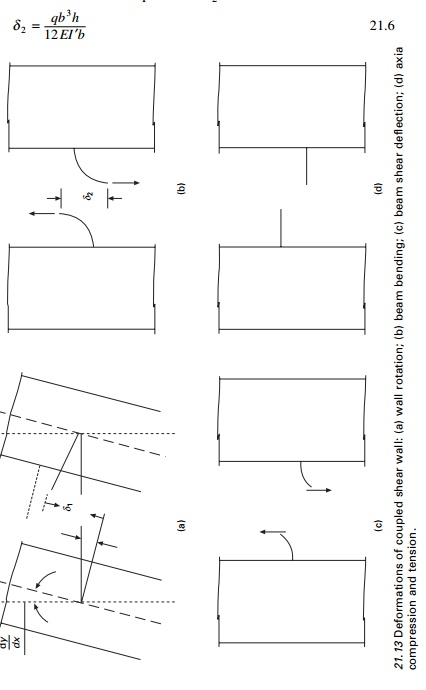
Beam shear deflection
The same shear force
causes a deformation ╬┤3 as

Axial compression and
tension
The displacement ╬┤4 is the
relative displacement of the two wall elements due to axial deformations of the
walls caused by T acting as a vertical wall on the wall elements
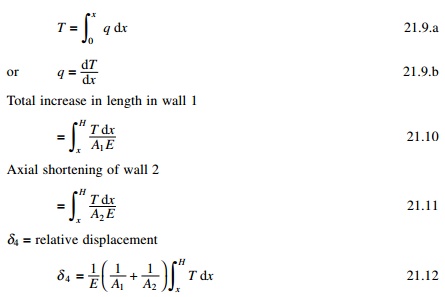
Since the two walls are
connected, the compatability and stipulation that the relative displacement
vanishes
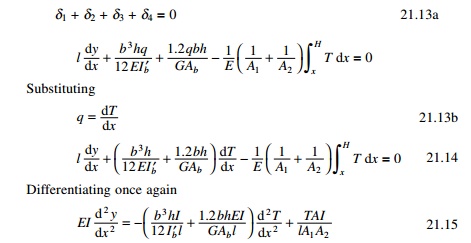
The first two terms on the
right-hand side of the above equation which pertain to bending and shear
deflection of the beam and can be combined to a single term by reducing moment
of inertia to include shear deformation as
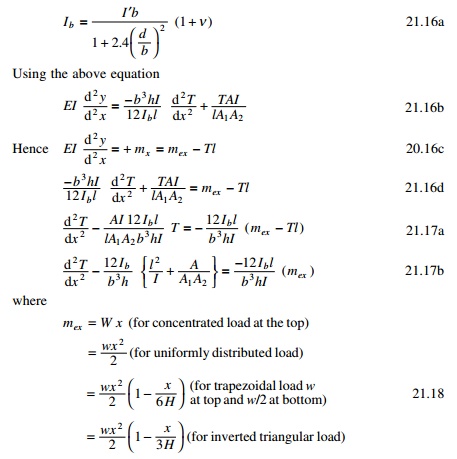
2 Coupled shear wall
subjected to uniformly distributed load)
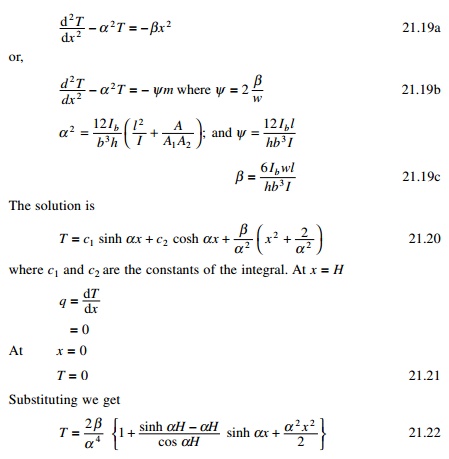
Once the distribution of
force T has been obtained the shear force in the coupling beam may be
determined as the difference in values of T at levels h/2 above
below and above that level

The general expression for
deflection y at a point x can be
obtained by integrating with the expression

where H is measured
from the top. Although inter-storey drifts are important most usually in
preliminary analysis, the maximum deflection at the top is of prime interest.
This is given by the following expression
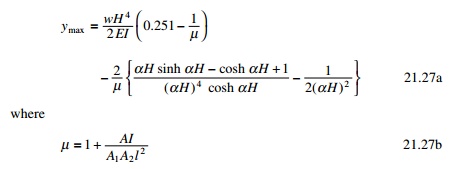
To analyse a system of coupled shear wall by the method
requires laborious calculation. Several researchers have proposed simplified
procedures. Coull and Choudhury (1967) proposed the following method. The
stress distribution of coupled shear walls is obtained as a combination of two
distinct actions.
1.
Walls acting together as a single composite
cantilever with neutral axis located at the centroid of two elements.
2.
Walls acting as two independent cantilever bending
about their neutral axis. Semi-graphical methods are also presented for rapid
design.
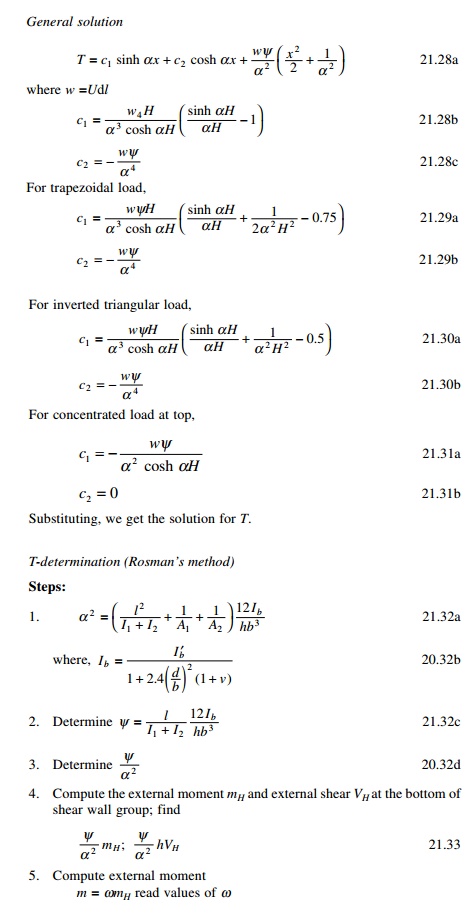
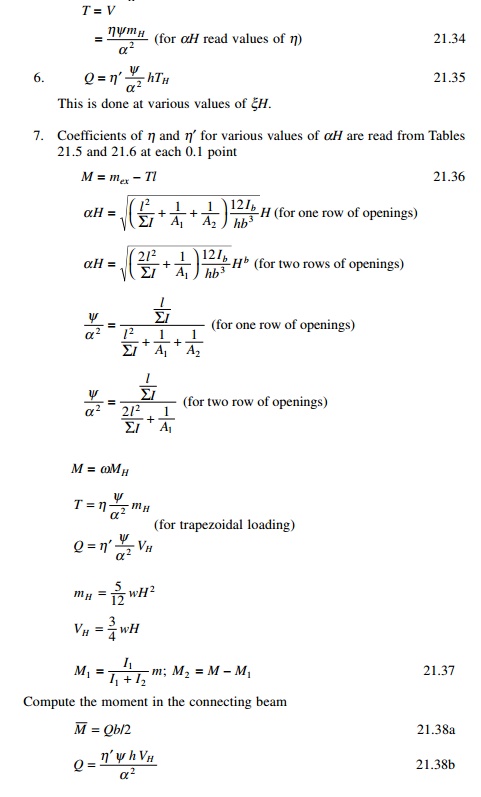
Example 21.2
Analyse the shear wall
shown in Fig. 21.14. Thickness of wall = 300 mm; width of I wall = 4.88 m;
width of II wall = 2.44 m Width of
opening = 2.44m.
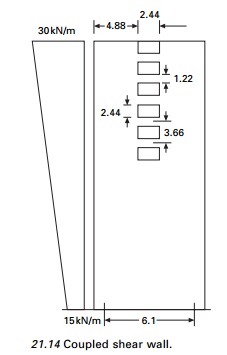
Solution
Total
width = 4.88 + 4.88 = 9.76
I = 2.44+
2.44+ 1.22 = 6.1 m
b = 2.44 m
d = 1.22 m
H = 73.152
m h = 3.66 m
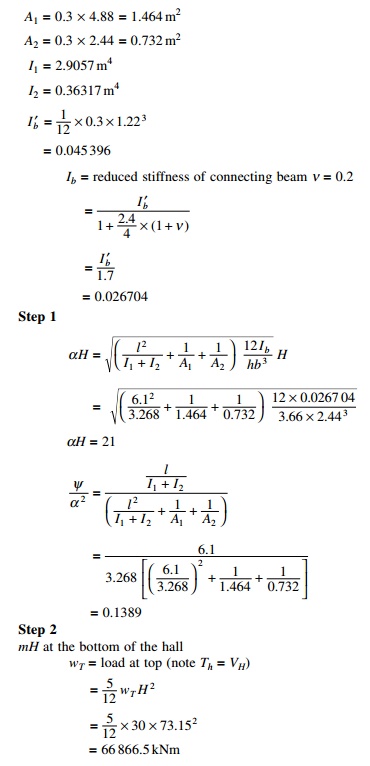
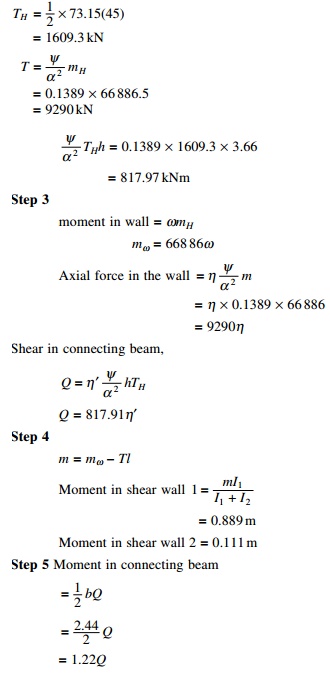
The
calculations for the variations of moments, T, in the walls and the
moment in the connecting beam are shown in Table 21.7 and the moments in both
the walls, the moment in the link beam and T in the walls are shown in Fig.
21.15.
Coupled
shear walls with two rows of openings are shown in Fig. 21.16.
Program 21.1 MATHEMATICA program for coupled
shear wall
The program is executed in MATHEMATICA and the variation of moment in wall 1, moment in wall 2, moment in link beam and T of the wall are as shown in Fig. 20.15 for the coupled shear wall of height 73.15 m with width of the walls 4.88 and 2.44 m and thickness of the wall 0.3 m, width and depth of opening as 2.44 m, depth of link beam as 1.22 m and centre to centre of the wall as 6.1 m subjected to trapezoidal load of 30 k/m at the top and 15 kN/m at the bottom. YoungŌĆÖs modulus and PoissonŌĆÖs ratio may be assumed as 20 GPa and 0.2 respectively. For the problem considered ╬▒2 = 0.08237; Žł = 00114; c2 = 15; c3= ŌĆō0.0346. The program in MATHEMATICA is shown on page 859.
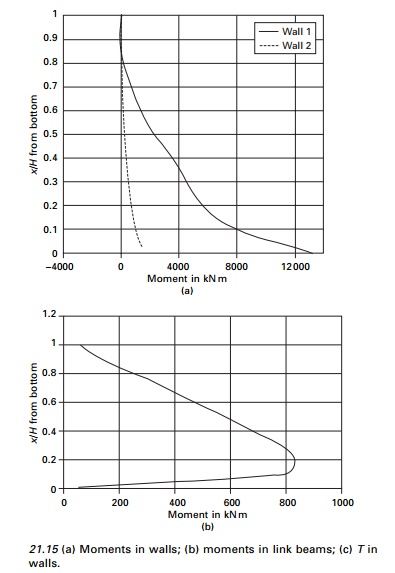

DSolve[{TŌĆÖŌĆÖ[x]-0.08237*T[x]==-0.0114*(15*x^2-0.0346*x^3),T[0]==TŌĆÖ[73.15]==0},T[x],x]
.
T=T[x]
t = ŌĆō6.01903
├Ś
10ŌĆō7eŌĆō0.287002x(8.37456 ├Ś 107
ŌĆō8.37456 ├Ś 107e0.287002x + 1.e0.574003x
ŌĆō579519.e0.287002xx2 + 7955.83e0.287002xx3)
Plot[t,{x,0,73.15}]
m=15*x^2-0.0346*x^3-t*6.1 m1=m*2.9557/3.2688 m2=m-m1 Plot[m1,{x,0,73.15}]
Plot[m2,{x,0,73.15}] q=D[t,x] mlb=q*2.44*3.66/2 Plot[mlb,{x,0,73.15}]
Dsolve[{yŌĆØ[x]
== m/(20000000 * 3.2688), y[73.15] == yŌĆÖ[73.15] == 0},
y[x],x] z=y[x]
z = 6.81818 ├Ś 10ŌłÆ14 eŌłÆ0.287002x(8.37456
├Ś 10 7 + 3.38539
├Ś1011 e 0.287002x
x ŌłÆ 3.44906
├Ś 106 e
0.287002x x3
+4367.98e 0.287002x x
4 ŌłÆ 6.04528e 0.287002x x4
ŌłÆ6.04525e 0.287002x
x5)
Plot[z,{x,0,73.15}]
Do[Print[ŌĆ£x,ŌĆØ ŌĆ£,t,ŌĆØ ŌĆ£,m1,ŌĆØ
ŌĆ£, m1,ŌĆØ ŌĆ£,mlb,ŌĆØ ŌĆ£,z,ŌĆØ ], {x,0,73.15,7.315}]
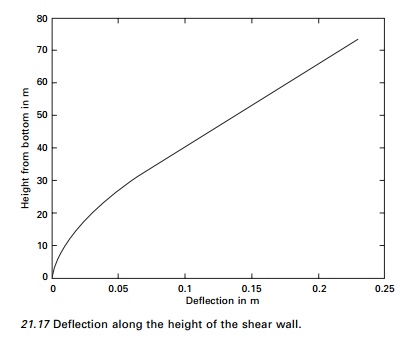
If the
same problem has to be carried out by finite element packages, the coupled
shear wall has to be modelled into four-node finite elements. Wilson (2002)
recommends that four-node element cannot model linear bending if fine mesh is
used and produces infinite stresses. Hence the coupled shear wall has to be
modelled into beam, column and rigid zones, otherwise the results are not
reliable. Parametric studies for the coupled shear considered could be easily
made by changing ╬▒, Žł in symbolic programming whereas
it cannot be done so easily with the finite element method. The deflected shape
of the shear wall is shown in Fig. 21.17.
Summary
In this chapter, analysis of shear wall with moment-resisting frame and coupled shear wall is discussed. Shear walls possess adequate lateral stiffness to reduce inter-storey distortions due to earthquake-induced motions. Shear walls reduce the likelihood of damage to non-structural elements of a building. When used with rigid frames, walls form a system that combines the gravity load-carrying efficiency of the rigid frames with the lateral load-resisting efficiency of the structural wall. Greater lateral stiffness is introduced in earthquake-resistant multi-storey shear wall buildings.
Related Topics